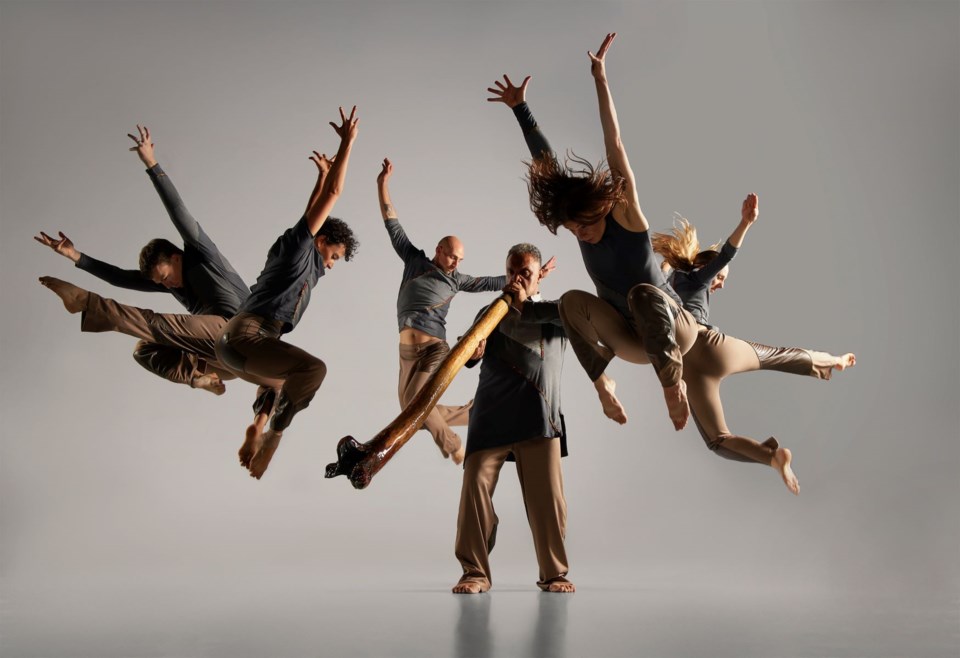A new production that combines the magic of dance and didgeridoo is coming to New West.
Produced by Montreal-based dance company, Sinha Danse, Out of Bark and Bone is a mix of movement, breath, voice, the sound of didgeridoo and live percussion.
"The dance is very vigorous but at times sombre and soft," said Roger Sinha, artistic director and founder of the contemporary dance company.
The choreography is designed to leave the audience "uplifted and calm."
"There is a circular aspect to the work; it's a journey. We come back at the end almost to the same place as the beginning, but not quite; we have grown, we have evolved," added Sinha, who was chosen by the Canadian Dance Assembly as the Canadian Ambassador for International Dance Day in 2017.
The dance, complemented with the deep drone of didgeridoo, is ultimately an exploration into the true nature of humans.
In an email interview with the Record, Sinha talked about his inspiration, his choice of musical instruments, and the seemingly cryptic link between bark and bone.
Why is the production called Out of Bark and Bone?
It’s a metaphor. The skin covers the bones of the dancer while the bark is the outer layer that covers trees.
You have to remove the bark to create a didgeridoo. As much as we as humans have to shed much of what we are on the exterior to try and find our true essence.
Your previous works have been inspired by literature and theatre (Burning Skin), poetry (Apricot Trees Exist) and live music (Sunya). What inspired Out of Bark and Bone?
Out of Bark and Bone was inspired by my interest in the connection between music, breath and movement. I am a choreographer, but I am also a didgeridoo player.
I often listen to other kinds of music while I play. One day, I heard Tanya Tagaq, a famous Canadian Inuit throat singer, on the radio. Her voice resonated so well with the deep bass "ohm" sound of the didgeridoo. The power of her breath took my breath away, literally!
It’s during that same period that I also met Katia Makdissi-Warren, a very talented Montreal-based composer and musician who is known for mixing in her contemporary pieces, elements of traditional and culturally diverse music from the Middle East, the West and Native America, among others.
Katia was working with two throat singers at the time, and so we decided to create something together.
Out of Bark and Bone was the result of our collaboration.
Your style is described to have elements of martial arts and the Indian classical dance, Bharatanatyam. Could you give some specific examples of dance moves that are incorporated in the piece?
We use different mudras such as Allapadma (fully bloomed lotus) or Katakamukha (opening in a bracelet). And the dancers do sing Konnakol, the art of performing percussion syllables vocally in South Indian Carnatic.
However, in this particular piece, I’d say there is little direct reference to my South Indian background but more so reference to the whole melting pot that surrounds me and makes me who I am: being half-Indian, half-Armenian, being born in England, growing up in Canada, my love for dance, for theatre, music and technologies.
This is a multi-instrument, multicultural work which meets many cultures and forms of expressions.
How did you go about selecting the musical instruments, and how did you integrate them with the dance?
I could say in some sense that the instrument chose me, in the case of the didgeridoo as I mentioned earlier.
And my dance work is very rhythmical and so are the compositions created by Katia Makdissi-Warren.
Live percussion performed by musicians on stage was thus a natural choice for this piece.
Along with the didgeridoo and the RAV drum, which makes soft melodies, I also use a sound software called Ableton. The sound effects are randomly selected by my software when I play an instrument. This gives different results every time we perform — which allows my dancers to improvise in certain sections.
I love the good blend between musical and dance elements this brings.
How did Out of Bark and Bone change you as a dancer and as a person?
For the first time in my long career (Sinha founded Sinha Danse in 1991),as a choreographer and dancer, I also appear as a musician. In this piece, I dance for a few minutes, but I mostly play.
I also encouraged the dancers to be themselves — to move the way they would like to move, not just how I ask them to move. Much of the work is choreographed and structured with my vocabulary, but the interpreters contributed significantly to the final result.
I believe that in order to be a true artist, one has to let go of ego.
This work helped us — choreographer and dancers — to grow together. It was a collaborative, shared experience. This creation is very much about the individual versus the group. In the end, we are an ensemble.
The individual experience is important, but undoubtedly our collective experience is what makes us grow and become better human beings.
Out of Bark and Bone will be performed as part of Outside/In Canadian Performance Series at the Anvil Theatre (777 Columbia St.) at 7.30 p.m. on March 18. The event is free for all.




